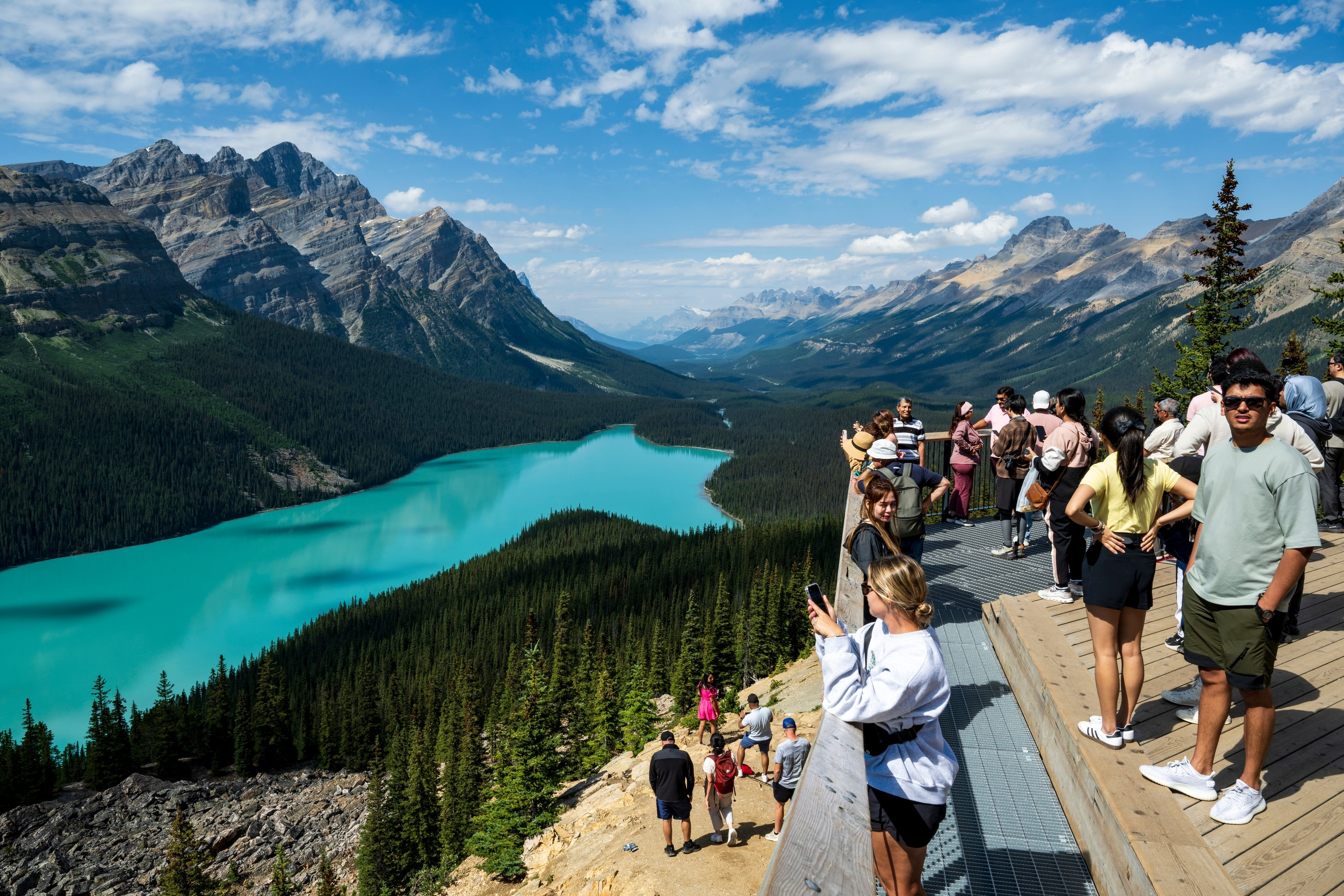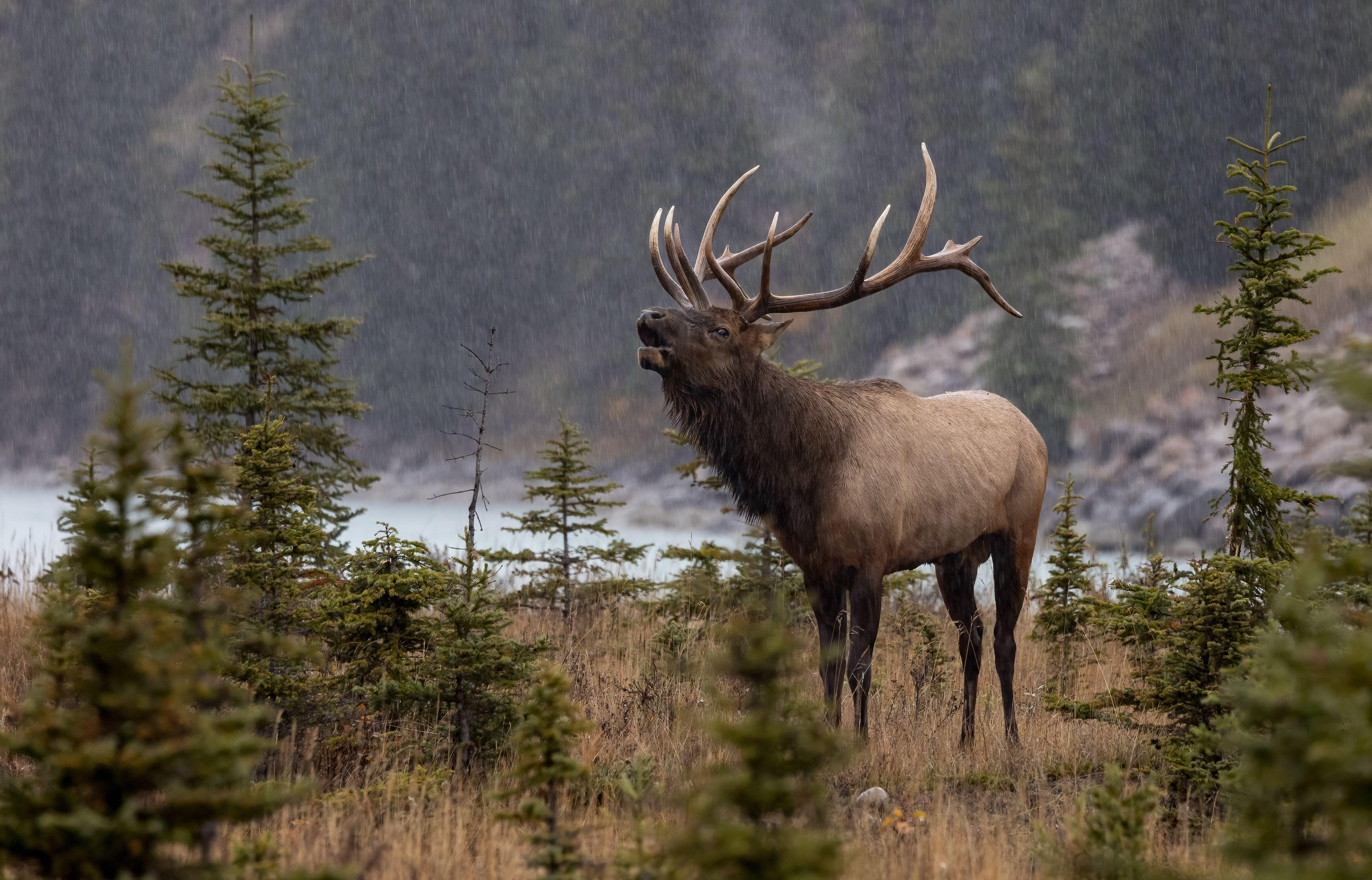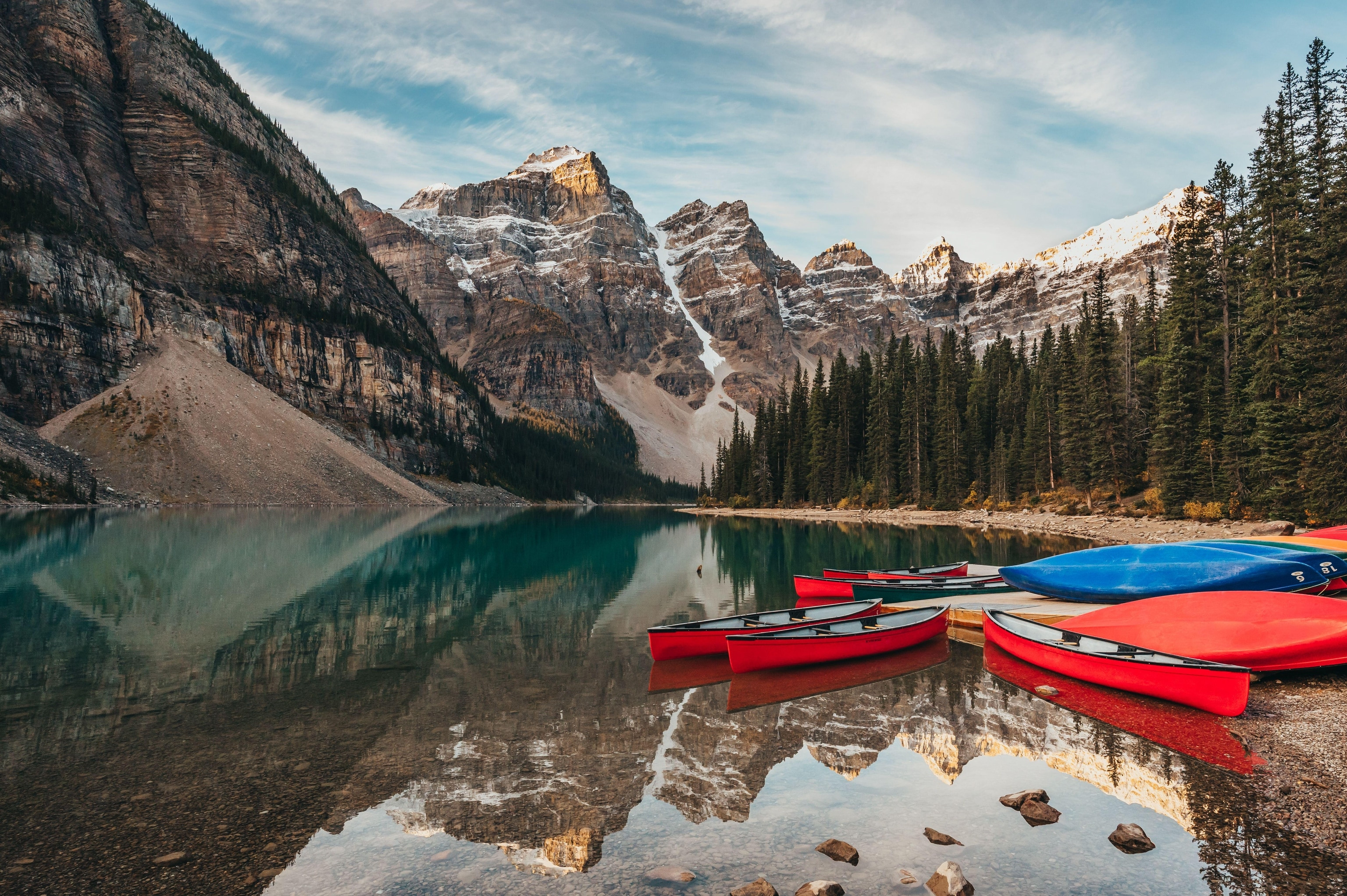Planning a trip to the Canadian Rockies? Banff Travel offers an incredible experience with stunning mountain scenery, turquoise lakes, and abundant wildlife. SIXT.VN is here to help you plan your perfect Banff adventure with essential tips, must-see locations, and practical advice for an unforgettable journey. Get ready to explore one of the most beautiful national parks in the world, and let SIXT.VN take care of the details so you can focus on making memories in the Canadian Rockies. Banff adventures, Canadian Rockies, and glacier-fed lakes are waiting for you.
1. What Makes Banff Travel So Special?
Banff National Park, Canada’s first and most majestic national park, offers a stunning combination of Rocky Mountains, deep valleys, glaciers, and tranquil lakes, captivating over four million annual visitors. Kelly Veillette, the park’s public relations and communications officer, highlights that Banff is more than a destination; it is a vital reminder of preserving wild spaces for future generations. Banff provides a unique opportunity to connect with nature.
2. Banff Travel Fast Facts
| Fact | Detail |
|---|---|
| Location | Alberta, Canada |
| Established | 1885 |
| Size | 1.64 million acres |
| Annual Visitors | 4.28 million (2023) |
| Entrance Fees | From $11 (U.S. $8) per person |
| Website | parks.canada.ca/pn-np/ab/banff |
3. Where Can I Find the Best Views for Banff Travel?
The Banff Gondola provides an eight-minute ride to the summit of Sulphur Mountain (8,041 feet), where you can enjoy panoramic views of Banff Town, the Bow Valley, and six mountain ranges. According to Banff Jasper Collection, the summit includes two restaurants and a boardwalk trail to the Sulphur Mountain Cosmic Ray Station National Historic Site. Mount Norquay offers a chairlift ride to a bistro-style café at nearly 7,000 feet, providing another vantage point over the Bow Valley.
 A group of tourists stands on a platform overlooking a bright blue lake surrounded by forest and mountains.
A group of tourists stands on a platform overlooking a bright blue lake surrounded by forest and mountains.
The viewpoint on Peyto Lake offers a stunning view of the lake. The alt text is: Peyto Lake Viewpoint: Tourists admiring the vibrant blue waters of Peyto Lake in Banff National Park, surrounded by lush forests and towering mountains.
4. What are the Best Trails for Banff Travel?
Thirty trails wind through Bow Valley and the mountains around Banff, offering options for all skill levels. The Tunnel Mountain hike, starting from the east side of town, is a popular three-mile option. The Banff Legacy Trail, a 16.6-mile paved route between Banff and Canmore, is ideal for cycling and offers scenic views. Farther up the valley, the Johnson Canyon Trail leads to stunning waterfalls and the Ink Pots mineral pools.
The Lake Louise Shoreline Trail offers an easy walk behind the historic hotel, while the Plain of the Six Glaciers Trail can be combined with the Lake Agnes Trail for a nine-mile loop that includes a spectacular glacier-carved valley and the Lake Agnes Tea House. According to Parks Canada, the Banff Legacy Trail is generally open from mid-April to mid-October, depending on snow conditions.
5. What Unique Trails Should I Consider for Banff Travel?
Kelly Veillette recommends the Sundance Canyon Trail near the Cave & Basin National Historic Site for a mix of easy and moderate hikes. “The paved path provides stunning views of the Bow River and surrounding mountains,” she explains. “After a gentle climb, the trail becomes more rugged, looping through a water-filled canyon. It’s a peaceful, scenic hike with beautiful mountain and canyon views.” Backpackers can also tackle the Sawback Trail, a rugged 46-mile route between Banff Town and Lake Louise, typically taking seven days to complete.
6. Where Can I See Wildlife During Banff Travel?
Wildlife is more easily spotted on secondary roads and footpaths, especially at dawn and dusk. Elk often graze on the Banff Springs Golf Course and around Vermillion Lakes. Bighorn sheep frequent Mount Norquay and Lake Minnewanka, while mountain goats inhabit the cliffs along the Icefield Parkway and the Mount Bourgeau Trail. According to the Banff National Park website, maintaining a safe distance is essential. Stay at least 100 meters away from carnivores like bears, cougars, and wolves, and 30 meters from ungulates like elk, deer, and sheep.
 An elk with antlers in the woods near a lake.
An elk with antlers in the woods near a lake.
Elk grazing peacefully at Vermillion Lakes. The alt text is: Banff Elk: An elk with large antlers grazes near a lake in Banff National Park during mating season.
7. How Can I Experience Banff Travel Like a National Geographic Explorer?
Alison Criscitiello, director of the Canadian Ice Core Lab at the University of Alberta, recommends the Valley of Ten Peaks at Moraine Lake. “To have terrain like that so accessible is mind-blowing,” she says. She also suggests long-distance ski routes like the Wapta Icefield traverse and Bow-Yoho traverse for spectacular scenery. For shorter routes, consider the Cory-Edith loop for alpine skiing or the Tunnel Mountain-Minnewanka-Two Jack loop for biking.
8. What are the Top Experiences for Banff Travel?
Banff has transformed from a 19th-century railroad stop into a thriving resort town with hotels, restaurants, art galleries, and outdoor adventure outfitters. The Banff National Park Visitor Centre provides the latest information on park activities, road conditions, wildlife sightings, and weather. The Banff Park Museum National Historic Site showcases Victorian-era zoological, botanical, and geological specimens, while the Whyte Museum of the Canadian Rockies specializes in regional art and architecture.
Mount Norquay offers skiing, snowboarding, and tubing in winter, and hiking and mountain biking in summer. It also features the park’s only Via Ferrata, a guided rock-climbing experience. According to Banff.ca, Banff Avenue is a popular spot for tourists to explore local shops and enjoy stunning views of Cascade Mountain.
 Red and blue canoes docked at a lake in the mountains.
Red and blue canoes docked at a lake in the mountains.
The peaceful scenery of Moraine Lake. The alt text is: Moraine Lake Canoes: Colorful canoes docked at Moraine Lake in Banff National Park, surrounded by towering mountains and pristine waters.
9. What Are the Must-See Lakes During Banff Travel?
Lake Louise, named after Queen Victoria’s fourth daughter, is renowned for its stunning alpine scenery, ideal for paddle sports in summer or lake fishing and ice-skating in winter. The historic Château Lake Louise, opened in 1911, offers afternoon tea with views of the lake. The Icefields Parkway (Highway 93) meanders 144 miles through the Canadian Rockies to Jasper Village, offering views of rivers, waterfalls, snowy peaks, and glaciers. Bow Lake provides another photogenic stop with the Bow Glacier Falls Trail and the Lodge at Bow Lake.
10. What Activities are Best for Families During Banff Travel?
Families can enjoy the Banff Gondola, guided tours from Banff Cycle + Sport, and float trips with Rocky Mountain Raft Tours. Lake Minnewanka offers rental canoes and kayaks and scenic boat cruises to Devil’s Gap. Banff Upper Hot Springs provides year-round soaking in a warm outdoor pool. For indoor activities, consider museums, Eureka Banff escape rooms, High Rollers bowling alley, and Lux Cinema. In winter, skiing and snowboarding at Banff Sunshine, Lake Louise, and Mount Norquay, plus snowshoeing, cross-country skiing, and sleigh rides at Brewster Stables are popular.
According to Travel Alberta, Banff Upper Hot Springs is a perfect way to relax and warm up during cool nights.
 People in an outdoor swimming pool with a view of mountains.
People in an outdoor swimming pool with a view of mountains.
The Banff Upper Hot Springs provides a unique hot spring experience. The alt text is: Banff Hot Springs: Visitors enjoying the warm waters of Banff Upper Hot Springs with scenic mountain views in the background.
11. Where Can I Stay During Banff Travel?
Banff offers accommodation options from world-famous lodges to campgrounds. The Fairmont Banff Springs, founded in 1888, offers upscale guest rooms, gourmet dining, and a luxury spa. The Fairmont Chateau Lake Louise provides astonishing views and elegant afternoon tea. Baker Creek by Basecamp offers log cabins along the Bow River with bike and fishing rod rentals. Parks Canada manages thousands of campsites in 17 developed campgrounds, and more than 50 primitive campgrounds are scattered throughout the park’s backcountry.
12. What Fees and Passes Do I Need for Banff Travel?
Admission to the national park is $11 (U.S. $8) for adults, $9.50 (U.S. $7) for seniors, and $22 (U.S. $16) for families. A Parks Canada Discovery Pass, good at all Canadian national parks for an entire year, costs $75.25 (U.S. $54) for adults, $64.50 (U.S. $46) for seniors, and $151.25 (U.S. $108) for families.
13. How Do I Get to Banff for My Banff Travel?
Banff National Park is located 80 miles west of Calgary on the Trans-Canada Highway. Calgary’s international airport is serviced by major national and international carriers. Brewster Express offers coach transfers from the airport or downtown Calgary to Banff Town and Lake Louise. Another option is a two-day train journey from Vancouver on the Rocky Mountaineer.
14. What is the Best Time to Visit Banff for My Banff Travel?
Banff National Park is open year-round. Summer is popular for hiking, paddling, mountain biking, cycling, photography, and climbing. The best time for viewing seasonal color is fall when the larch trees turn yellow. In winter, the mountain landscape makes for incredible downhill and cross-country skiing or snowboarding. According to Ski Banff, the Banff ski season typically runs from November to May, one of the longest in North America.
15. How Can I Get Around During My Banff Travel?
ROAM is the public transit bus system in Banff, Lake Louise, and Canmore, using environmentally-friendly hybrid vehicles. The GuideAlong app offers self-drive tours downloadable on smartphones.
16. Are Pets Allowed During My Banff Travel?
Dogs must be kept on a leash and under control at all times, and owners must remove and dispose of any dog waste. There are two leash-free dog parks in Banff Town.
17. How Accessible is Banff for My Banff Travel?
The Banff Gondola, Lake Minnewanka tour boats, and Banff Upper Hot Springs are accessible, as are ROAM buses. Accessible trails range from the lakeside path at Lake Louise to the lengthy Banff Legacy Trail along the Bow River. Accessible public restrooms are available in Banff and Lake Louise, along the Icefields Parkway, and at all drive-in campgrounds. Banff Scooter Company rents mobility scooters, and Rocky Mountain Adaptive offers accessible skiing programs.
18. What are the Best Hidden Gems for Banff Travel?
While popular spots like Lake Louise and Banff Avenue are must-sees, Banff National Park offers many hidden gems. Explore the serene beauty of Peyto Lake, accessible via a short hike from the Icefields Parkway, offering stunning turquoise waters and panoramic mountain views. Discover the Ink Pots near Johnston Canyon, where you can find bubbling mineral springs in a picturesque meadow. For a quiet escape, hike toConsolation Lakes near Lake Louise, which offers a tranquil alpine setting away from the crowds.
19. How Can I Ensure Responsible and Sustainable Banff Travel?
To protect Banff National Park’s natural beauty, practice responsible and sustainable travel. Stay on marked trails to avoid disturbing wildlife and vegetation. Dispose of waste properly and pack out everything you pack in. Respect wildlife by maintaining a safe distance and never feeding animals. Support local businesses that prioritize sustainability and conservation. Consider using public transportation or carpooling to reduce your carbon footprint. By traveling responsibly, you can help preserve Banff for future generations.
20. What Cultural Experiences Can I Enjoy During Banff Travel?
Banff offers a range of cultural experiences that enrich your visit. Visit the Whyte Museum of the Canadian Rockies to learn about the region’s art, culture, and history. Attend a performance at the Banff Centre for Arts and Creativity, which hosts music, dance, theater, and visual arts events. Explore the Cave and Basin National Historic Site, the birthplace of Banff National Park, and learn about its history and significance. Participate in Indigenous cultural experiences to gain insight into the traditions and heritage of the First Nations people who have lived in the area for centuries.
21. Banff Travel: Frequently Asked Questions
1. When is the best time to see the Northern Lights in Banff?
While not as frequent as in more northern locations, the Northern Lights can sometimes be seen in Banff during the winter months. The best time is during periods of high solar activity and clear, dark skies.
2. Do I need a reservation to visit Banff National Park?
No, you do not need a reservation to enter Banff National Park, but you do need a Parks Canada pass. Reservations are recommended for campgrounds and some popular attractions, especially during peak season.
3. What are the best day hikes in Banff for beginners?
Easy day hikes include the Lake Louise Shoreline Trail, Tunnel Mountain, and a portion of the Johnston Canyon Trail.
4. Can I swim in Lake Louise?
Swimming in Lake Louise is not recommended due to the extremely cold water temperatures.
5. What should I pack for a trip to Banff?
Pack layers of clothing, including warm jackets, hats, gloves, and waterproof gear. Sturdy hiking shoes, sunscreen, insect repellent, and a camera are also essential.
6. Are there bears in Banff National Park?
Yes, Banff is home to both grizzly and black bears. It’s essential to carry bear spray, make noise while hiking, and store food properly.
7. How far is Banff from Calgary?
Banff is approximately 80 miles (130 kilometers) west of Calgary, about a 1.5-hour drive.
8. What are the best activities in Banff during the winter?
Winter activities include skiing, snowboarding, snowshoeing, ice skating on Lake Louise, and visiting the Banff Hot Springs.
9. Can I use my U.S. dollars in Banff?
Canadian currency is preferred, but most businesses in Banff accept U.S. dollars. However, you may receive a less favorable exchange rate.
10. Are there guided tours available in Banff?
Yes, many guided tours are available, including wildlife tours, hiking tours, and sightseeing tours. Check with local tour operators for options.
Planning a trip to Banff National Park promises an unforgettable experience filled with stunning scenery and incredible adventures. With SIXT.VN, you can easily arrange your airport transfers, book comfortable accommodations, and discover the best tours to make the most of your visit. Don’t let planning stress you out; let SIXT.VN handle the details while you prepare to be amazed by the Canadian Rockies.
Ready to start your Banff adventure? Contact SIXT.VN today!
- Address: 260 Cau Giay, Hanoi, Vietnam
- Hotline/Whatsapp: +84 986 244 358
- Website: SIXT.VN
Book your airport transfers, hotels, and tours with SIXT.VN and experience Banff National Park like never before!



